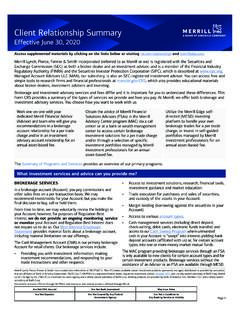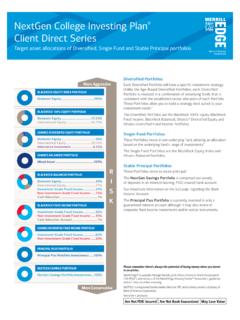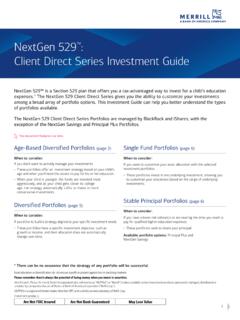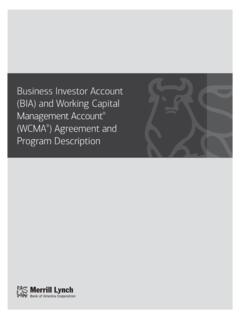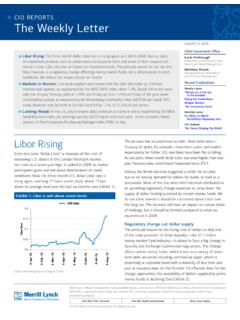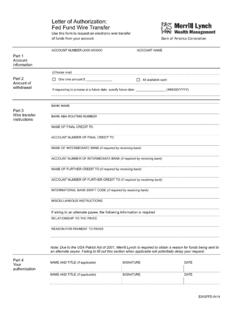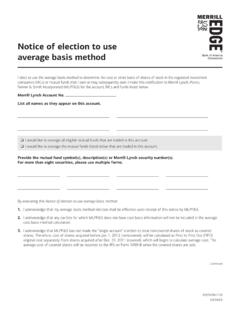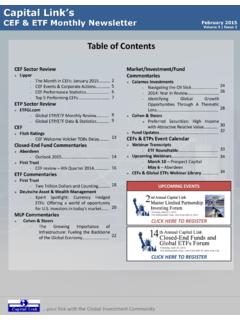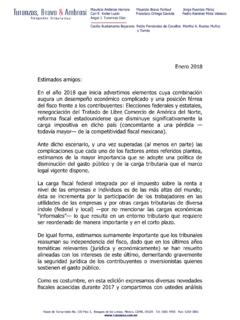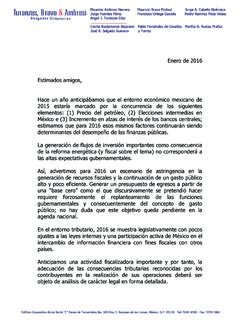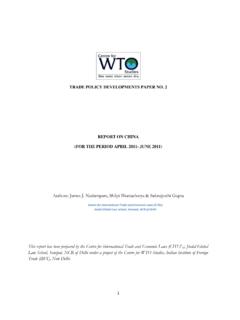Transcription of CIO REPORTS The Weekly Letter - Merrill Lynch
1 CIO REPORTSThe Weekly LetterMerrill Lynch Wealth Management makes available products and services o ered by Merrill Lynch , Pierce, Fenner & Smith Incorporated (MLPF&S), a registered broker-dealer and member SIPC, and other subsidiaries of Bank of America Corporation (BofA Corp.).Investment products:Are Not FDIC InsuredAre Not Bank GuaranteedMay Lose Value 2016 Bank of America Corporation. All rights 14, 2016 Remodeling REITs: A new sector for Real Estate Investment Trusts (REITs) is being created in the Global Industry Classification Standard (GICS) on which many investment funds base portfolio weightings. We are taking a closer look at opportunities that this coming change may present for investors along with the traditional advantages of and concerns with the asset class, and areas of interest in today s market.
2 Markets in Review: Last week equities declined, with the S&P 500 index down , while international equities, as represented by the MSCI EAFE Index were lower. Bonds rallied on the week, with the 10-year Treasury yield ending at , down from in the prior week. Commodity prices as measured by the Bloomberg Commodity Index rose , as WTI crude oil climbed , to $49. 07, and gold gained , to $1, per ounce. Looking Ahead: In the , the National Association of Home Builders (NAHB) housing index is expected to slip, and housing starts to decline. Eurozone Consumer Price Inflation (CPI) is expected to rise to month-over-month (MoM) and remain unchanged at year-over-year (YoY).
3 Chief Investment OfficeEmmanuel D. HatzakisDirectorJon LieberkindVice PresidentRecent PublicationsWeekly LetterHome on the RangeInfrastructure ImpulseEurope Corporate EasingThe Long and Short of JapanMonthly LetterInvesting in a Range-Bound MarketCIO OutlookThe Forces Shaping Our WorldRemodeling REITsIn our April 5 Weekly Letter , REITs Enter Adolescence, we wrote about Real Estate Investment Trusts (REITs) and their place among equity and fixed income allocations in investor portfolios. We are taking another look to examine opportunities and issues that might arise as a result of a change to the Global Industry Classification Standard (GICS) that takes effect after the market close on August 31st.
4 The industry weightings for many investment funds reflect, to one degree or another, this standard classification. Most REITs are being removed from the Financials and established as their own sector, adding an 11th top-level category. As this event is approaching, we already see portfolio managers making some adjustments to their holdings to reflect the new brief refresher on REITs1 REITs are organizations engaged in real estate investing. Equity REITs own and typically operate income-producing real estate properties. Mortgage REITs do not directly own assets but lend to owners of real estate. There are a few hybrids equity and mortgage REITs. Exhibit 1 shows a breakdown of REITs by type.
5 In the GICS realignment, Mortgage REITs will remain within Financials while the rest will form their own legal structure of REITs makes them attractive to income-oriented investors. The entities must distribute 90% of their taxable net income to shareholders, and do not pay corporateExhibit 1: Breakdown of REITs by type (market cap in billions and % of total market cap)n Equity REIT n Mortgage REIT$ Apartments$ Self-Storage$ Free Standing$ Regional Malls$ Mortgage$ Specialty$ Health Care$ Industrial$ Timber$ Office$ Diversified$ Manufactured Homes$ Infrastructure$ Lodging Resorts$ Single Family Homes$ Shopping Centers$ Data Centers$ TotalSource: NAREIT, BofAML Global Research and Merrill Lynch Chief Investment Office.
6 Market capitalization of the FTSE NAREIT All Equity REITs Index and its subsectors, and of the FTSE NAREIT Mortgage REITs Index is shown as of February 29, 2016. Totals may be off due to rounding. Past performance is no guarantee of future results. 1 For a more comprehensive treatment: BofAML Global Research. May 2, 2016. REITs Primer. 7th Edition: a comprehensive handbook for a new GICS sector. CIO REPORTS The Weekly Letter 2income taxes but are taxed at the investor level, like income from direct real estate holdings. There may be significant inflowsManagers are currently underweight REITs in their portfolios, as they are in Telecoms and Utilities, two sectors with similar characteristics, although in aggregate the REIT underweights are larger.
7 This raises the risk that they won t match their benchmarks, and with the realignment we expect them to respond by buying more REITs, especially for portfolios with constraints on sector tilts. BofA Merrill Lynch (BofAML) Global Research2 has estimated that managers purchases of REITs intended to reduce the underweights could bring inflows of $30 billion across small-, medium- and large-cap REITs. Investment firm Cohen & Steers3 goes even further to estimate a potential $100 billion of inflows if funds bring their REIT holdings in line with index weightings that reflect the new sector classifications. foreign buying should contribute to the inflows since the recently passed foreign Investment in Real Property Tax Act (FIRPTA) could increase overseas investors holdings in commercial real estate.
8 Some of these inflows are already happening, as investors respond to the GICS realignment. With the low market liquidity typically observed over summer months, these inflows could exert more upward pressure on prices than they normally potentially positive effect of the new standalone REIT sector is that it should offer managers an opportunity to reduce the volatility of their funds to the extent that they add REITs and cut back on Financials, since Financials is one of the most volatile and potential issuesCompared to other yield-focused sectors, REITs offer distributions that are higher than typical stock dividends along with favorable growth potential for the payouts. Coupled with their attractive long-term rates of return, these attributes could make them appealing to yield-seekers and to a potentially larger investor heightened visibility brought about by the reclassification could prompt REIT managers to seek economies of scale and benefits from geographic diversification, resulting in consolidation through M&A or privatization.
9 In anticipation of that, fund managers fearful of missing the deal wave could bid up prices. In a portfolio context, REITs can offer significant diversification benefits. They can provide exposure to real estate, an asset class whose returns have not been highly correlated with those of equities or fixed income. What is more, REITs draw from sources of return of both of these asset classes. Like bonds, they may offer more income certainty due to the longer-term nature of leases typical in most REIT subsectors. On the other hand, the mark-to-market character of leases provides equity-like exposure to the economic potential issue, which might explain the current underweighting, is that REITs are poorly understood by traditional fund managers.
10 When using common valuation metrics, such as price-to-earnings ratios, REITs do not do well on value screens. They may also rank poorly in growth screens due to their low long-term growth rates compared to other sectors. This gives an edge to active managers specializing in REITs, who tend to be proficient in the earnings and valuation metrics used in the differ in approachAmong the REIT sub-sectors, Apartments and Data Centers enjoy strong fundamentals. Self-storage could also benefit from the housing preferences of Millennials, and the aging of Baby Boomers could be a boost for Health Care in the long term. Outside the , we expect opportunities to arise in Europe and Japan, where central bank policies should eventually support economic growth and real estate valuations.
